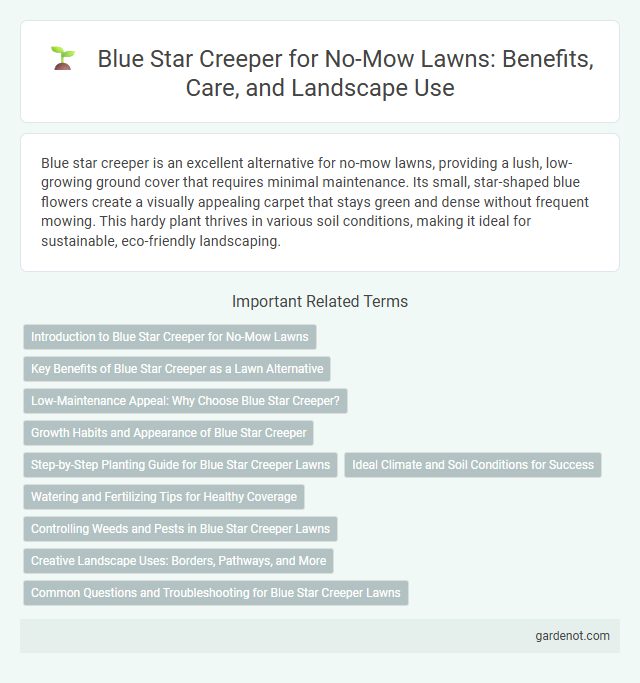Blue star creeper is an excellent alternative for no-mow lawns, providing a lush, low-growing ground cover that requires minimal maintenance. Its small, star-shaped blue flowers create a visually appealing carpet that stays green and dense without frequent mowing. This hardy plant thrives in various soil conditions, making it ideal for sustainable, eco-friendly landscaping.
Introduction to Blue Star Creeper for No-Mow Lawns
Blue Star Creeper (Isotoma fluviatilis) is a low-growing, dense groundcover ideal for no-mow lawns due to its minimal height and spreading habit. This perennial plant features tiny star-shaped blue flowers and thrives in various soil types, providing a lush, carpet-like appearance that requires little maintenance. Its tolerance to foot traffic and rapid spreading make Blue Star Creeper a sustainable, attractive alternative to traditional turfgrass in no-mow lawn designs.
Key Benefits of Blue Star Creeper as a Lawn Alternative
Blue star creeper serves as an excellent no-mow lawn alternative due to its low maintenance requirements and ability to thrive in partial shade and foot traffic. This groundcover features vibrant green foliage with small blue flowers, enhancing aesthetic appeal while reducing water usage compared to traditional grass. Its dense mat formation helps prevent soil erosion and suppresses weed growth, making it an environmentally friendly and durable option for sustainable landscaping.
Low-Maintenance Appeal: Why Choose Blue Star Creeper?
Blue Star Creeper offers exceptional low-maintenance appeal due to its hardy nature and ability to thrive in various soil conditions with minimal watering. This fast-spreading ground cover stays lush and green without frequent mowing, making it an ideal choice for no-mow lawns. Its resilience to foot traffic and shade tolerance further reduce upkeep, ensuring a beautiful, low-effort landscape.
Growth Habits and Appearance of Blue Star Creeper
Blue Star Creeper (Isotoma fluviatilis) is a low-growing ground cover that spreads quickly through creeping stems, forming a dense mat ideal for no-mow lawns. Its small, bright green leaves create a lush carpet, while delicate light blue, star-shaped flowers bloom throughout the growing season, enhancing visual appeal. This hardy plant thrives in various soil types and can tolerate moderate foot traffic, making it perfect for sustainable, low-maintenance landscapes.
Step-by-Step Planting Guide for Blue Star Creeper Lawns
Prepare soil by removing debris and loosening the top 2 inches to ensure proper root penetration for Blue Star Creeper. Space plugs or seeds evenly, maintaining 6-12 inches apart to promote dense, uniform growth in a no-mow lawn. Water consistently, keeping soil moist until established, then reduce frequency to encourage deep rooting and drought tolerance.
Ideal Climate and Soil Conditions for Success
Blue star creeper thrives in temperate to subtropical climates, where temperatures range between 60degF and 85degF, ensuring vigorous growth and dense ground cover. It prefers well-drained, sandy loam or loamy soils with a pH level between 6.0 and 7.5, facilitating optimal nutrient absorption and root development. Consistent moisture without waterlogging promotes resilience, making it an excellent choice for no-mow lawns in shaded or partially sunny areas.
Watering and Fertilizing Tips for Healthy Coverage
Blue star creeper thrives with consistent watering, ideally keeping the soil moist but not waterlogged to promote dense, healthy coverage. Fertilize this ground cover in early spring using a balanced, slow-release fertilizer to support vigorous growth and vibrant foliage. Avoid over-fertilizing, which can lead to excessive leaf growth at the expense of robust spreading.
Controlling Weeds and Pests in Blue Star Creeper Lawns
Blue star creeper (Isotoma fluviatilis) establishes a dense, low-growing mat that naturally suppresses weed growth by limiting sunlight and space for invasive species. Its resilience against many common lawn pests reduces the need for chemical treatments, promoting an eco-friendly, no-mow lawn maintenance approach. Regular monitoring and occasional spot treatments with organic herbicides help maintain optimal health and weed-free conditions in blue star creeper lawns.
Creative Landscape Uses: Borders, Pathways, and More
Blue star creeper (Isotoma fluviatilis) thrives as a low-growing ground cover, ideal for no-mow lawns, creating dense, lush mats that reduce maintenance. This versatile plant enhances landscape designs by forming attractive borders and softening hardscape edges along pathways with its delicate blue star-shaped flowers. Its tolerance to light foot traffic makes it perfect for filling spaces between stepping stones, offering an eco-friendly alternative to traditional grass in high-traffic areas.
Common Questions and Troubleshooting for Blue Star Creeper Lawns
Blue star creeper (Isotoma fluviatilis) is a low-maintenance ground cover often used as a no-mow lawn alternative due to its dense, spreading growth habit and tolerance for light foot traffic. Common issues include thinning patches caused by poor drainage, excessive shade, or improper watering, which can be resolved by improving soil conditions, ensuring at least partial sun exposure, and keeping the soil consistently moist but not waterlogged. To troubleshoot pests and diseases, monitor for signs of fungal infections like powdery mildew and use appropriate treatments such as fungicides or increasing air circulation around the plants.
Blue star creeper Infographic

 gardenot.com
gardenot.com